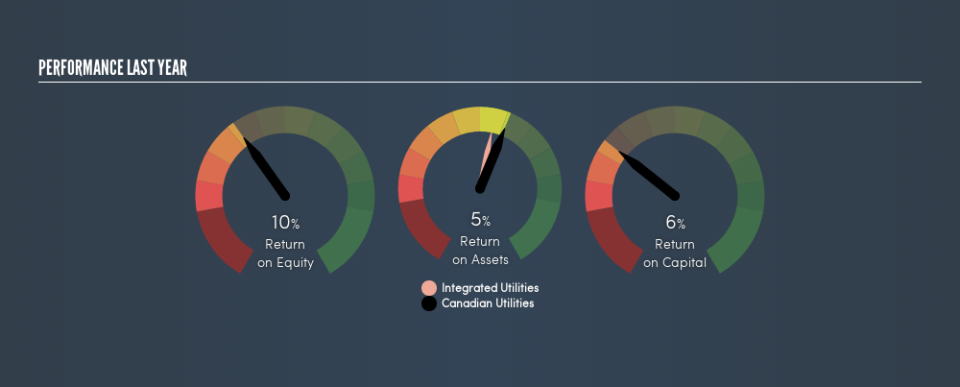Are Canadian Utilities Limited’s (TSE:CU) Returns Worth Your While?

Want to participate in a short research study? Help shape the future of investing tools and you could win a $250 gift card!
Today we are going to look at Canadian Utilities Limited (TSE:CU) to see whether it might be an attractive investment prospect. In particular, we'll consider its Return On Capital Employed (ROCE), as that can give us insight into how profitably the company is able to employ capital in its business.
First up, we'll look at what ROCE is and how we calculate it. Next, we'll compare it to others in its industry. And finally, we'll look at how its current liabilities are impacting its ROCE.
What is Return On Capital Employed (ROCE)?
ROCE is a measure of a company's yearly pre-tax profit (its return), relative to the capital employed in the business. All else being equal, a better business will have a higher ROCE. Overall, it is a valuable metric that has its flaws. Renowned investment researcher Michael Mauboussin has suggested that a high ROCE can indicate that 'one dollar invested in the company generates value of more than one dollar'.
So, How Do We Calculate ROCE?
Analysts use this formula to calculate return on capital employed:
Return on Capital Employed = Earnings Before Interest and Tax (EBIT) ÷ (Total Assets - Current Liabilities)
Or for Canadian Utilities:
0.058 = CA$1.2b ÷ (CA$22b - CA$1.7b) (Based on the trailing twelve months to March 2019.)
Therefore, Canadian Utilities has an ROCE of 5.8%.
View our latest analysis for Canadian Utilities
Does Canadian Utilities Have A Good ROCE?
ROCE is commonly used for comparing the performance of similar businesses. It appears that Canadian Utilities's ROCE is fairly close to the Integrated Utilities industry average of 5.4%. Separate from how Canadian Utilities stacks up against its industry, its ROCE in absolute terms is mediocre; relative to the returns on government bonds. Investors may wish to consider higher-performing investments.
You can click on the image below to see (in greater detail) how Canadian Utilities's past growth compares to other companies.
It is important to remember that ROCE shows past performance, and is not necessarily predictive. ROCE can be misleading for companies in cyclical industries, with returns looking impressive during the boom times, but very weak during the busts. ROCE is, after all, simply a snap shot of a single year. Future performance is what matters, and you can see analyst predictions in our free report on analyst forecasts for the company.
Canadian Utilities's Current Liabilities And Their Impact On Its ROCE
Liabilities, such as supplier bills and bank overdrafts, are referred to as current liabilities if they need to be paid within 12 months. Due to the way ROCE is calculated, a high level of current liabilities makes a company look as though it has less capital employed, and thus can (sometimes unfairly) boost the ROCE. To check the impact of this, we calculate if a company has high current liabilities relative to its total assets.
Canadian Utilities has total assets of CA$22b and current liabilities of CA$1.7b. Therefore its current liabilities are equivalent to approximately 7.7% of its total assets. With low levels of current liabilities, at least Canadian Utilities's mediocre ROCE is not unduly boosted.
Our Take On Canadian Utilities's ROCE
Canadian Utilities looks like an ok business, but on this analysis it is not at the top of our buy list. Of course, you might also be able to find a better stock than Canadian Utilities. So you may wish to see this free collection of other companies that have grown earnings strongly.
If you like to buy stocks alongside management, then you might just love this free list of companies. (Hint: insiders have been buying them).
We aim to bring you long-term focused research analysis driven by fundamental data. Note that our analysis may not factor in the latest price-sensitive company announcements or qualitative material.
If you spot an error that warrants correction, please contact the editor at editorial-team@simplywallst.com. This article by Simply Wall St is general in nature. It does not constitute a recommendation to buy or sell any stock, and does not take account of your objectives, or your financial situation. Simply Wall St has no position in the stocks mentioned. Thank you for reading.

 Yahoo Finance
Yahoo Finance 
